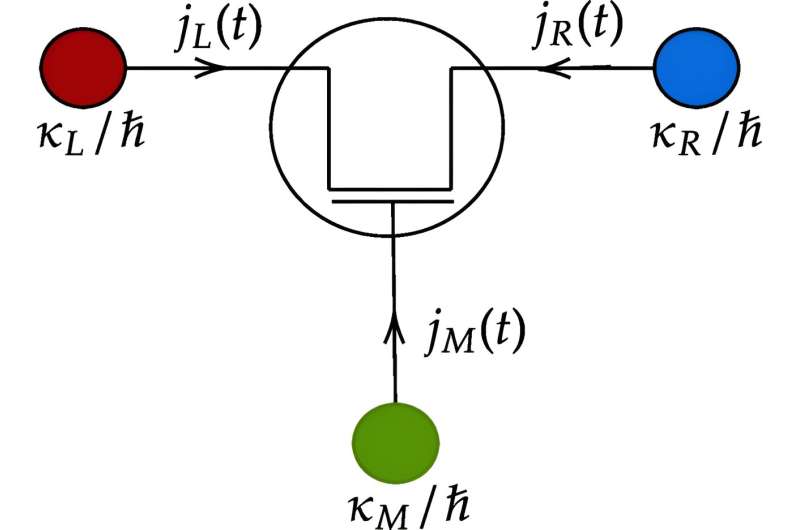January 2, 2024 dialog
This article has been reviewed according to Science X's editorial process and policies. Editors have highlighted the following attributes while ensuring the content's credibility:
fact-checked
peer-reviewed publication
trusted source
written by researcher(s)
proofread
Quantum thermal transistors: Harnessing quantum measurement and feedback

Researchers are actively engaged in the dynamic manipulation of quantum systems and materials to realize significant energy management and conservation breakthroughs.
This endeavor has catalyzed the development of a cutting-edge platform dedicated to creating quantum thermal machines, thereby unlocking the full potential of quantum technologies in advanced energy solutions.
Are we at the forefront of a novel energy management device?
The scientific community has redirected its focus toward pioneering the domain of quantum thermal transistors—a sophisticated apparatus designed for the precision management of heat transfer. In the relentless pursuit of optimal quantum device performance, a notable challenge arises within the intricate cooling and environmental regulation landscape. The current cooling infrastructures, particularly those catering to diverse qubit technologies, notably quantum computers, pose significant challenges, thus intensifying the call for avant-garde solutions.
In contemporary scientific discourse, quantum measurements and control have become pivotal in the design of quantum thermal machines for advanced energy management. These interventions can help preserve the inherent quantum properties of such devices while forestalling their undesirable transition into a classical state induced by environmental interactions, known as decoherence.
However, a formidable challenge arises from the potential introduction of noise by measurement probes, necessitating innovative solutions. In response to this critical issue, we have introduced an advanced theoretical framework—the conditioned quantum thermal transistor. This paradigm undergoes continuous monitoring orchestrated by its environmental milieu.
To comprehend and analyze this behavior, we have devised an elaborate stochastic noise model mirroring the small-signal model employed in classical transistors. This systematic approach enhances our understanding of the nuanced dynamics, contributing to the refinement and optimization of quantum thermal machine architectures. Our findings are published in the journal Physical Review B.
What's the use of a stochastic model?
As devices undergo miniaturization, their susceptibility to environmental influences assumes a greater significance, affording insights into the dynamic alterations within the system. The manifestation of intrinsic fluctuations stemming from thermal noise, coupled with extraneous perturbations such as measurements and feedback control, profoundly influence small-scale devices. The preemptive characterization of such stochastic behavior is invaluable, furnishing a comprehensive understanding of the inherent operational limitations embedded within these devices.
The maturation of a functional quantum thermal transistor remains at a nascent stage, necessitating ongoing refinement. At the same time, our current publication establishes a pioneering framework, and our forthcoming research aspires to study these devices' complex dynamics when subjected to feedback control through continuous measurements.
It is crucial to highlight that quantum feedback exhibits distinct characteristics from its classical electronic counterpart. Consequently, an extensive exploration is imperative to ascertain the seamless integration of quantum feedback mechanisms into thermal transistors, paving the way for the emergence of innovative and highly efficient heat management systems.
This story is part of Science X Dialog, where researchers can report findings from their published research articles. Visit this page for information about ScienceX Dialog and how to participate.
Uthpala N. Ekanayake earned her B.Sc. in electrical and electronic engineering (with first-class honors) from University of Peradeniya, Sri Lanka. Currently she is a PhD candidate and a member of the Advanced Computing and Simulations Laboratory at the Department of Electrical and Computer Systems Engineering, Monash University, Australia under the supervision of Prof. Malin Premaratne.
Malin Premaratne earned several degrees from the University of Melbourne, including a B.Sc. in mathematics, a B.E. in electrical and electronics engineering (with first-class honors), and a PhD in 1995, 1995, and 1998, respectively. Currently, he is a full professor at Monash University Clayton, Australia. His expertise centers on quantum device theory, simulation, and design, utilizing the principles of quantum electrodynamics. Professor Premaratne's unique approach harmonizes profound theoretical physics with pragmatic electrical engineering methods, establishing an interdisciplinary nexus between fundamental physics and translational engineering technology. Acknowledged for his substantial contributions to optics and photonics, he has received numerous fellowships, including the Fellow of the Optical Society of America (FOSA), the Society of Photo-Optical Instrumentation Engineers USA (FSPIE), the Institute of Physics U.K. (FInstP), the Institution of Engineering and Technology U.K. (FIET), and The Institute of Engineers Australia (FIEAust).
More information: Uthpala N. Ekanayake et al, Stochastic model of noise for a quantum thermal transistor, Physical Review B (2023). DOI: 10.1103/PhysRevB.108.235421
Journal information: Physical Review B



















